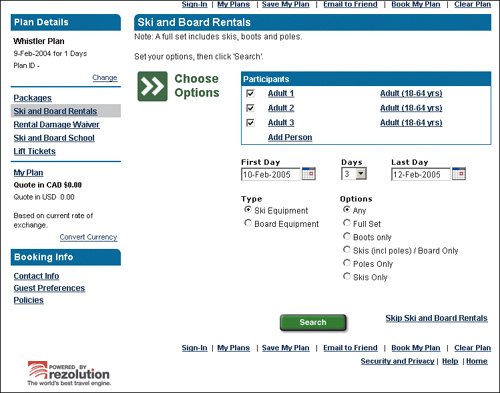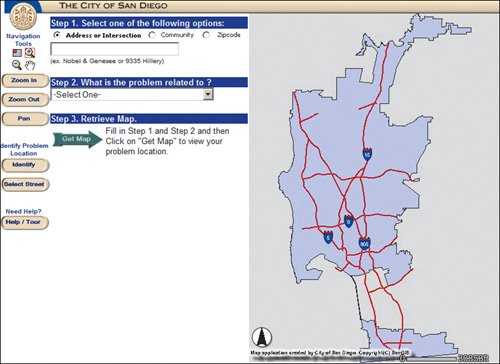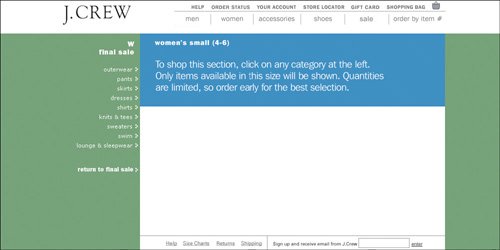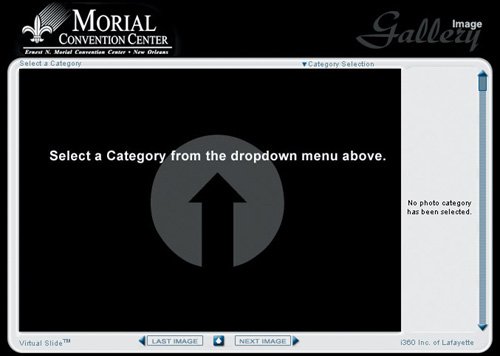Guiding Users, Step by Step
| When an interaction requires multiple steps, gently guide users through an expected linear process, but don't overwhelm them with options. Your goal is to create an experience that they find satisfying; people don't mind clicking through multiple pages as long as each click brings them closer to the desired result, at a reasonable pace. Interactions that are consistent with people's expectations feel pleasant. In fact, people who have a good experience on Web sites think their task takes less time (or clicks) than it actually does.
People don't mind clicking through multiple pages as long as each click brings them closer to the desired result. In fact, people who have a good experience on Web sites think their task takes less time than it actually does. Don't make people solve complex problems to proceed to the next page. Having a structured process helps them avoid making mistakes such as skipping steps. If a feature requires multiple steps, it's helpful to lay out a linear process so people know what to anticipate. Users will expend the effort to learn software that they've purchased or are required to use for work, but not to use Web sites. If the site doesn't serve their needs immediately, there are thousands of others vying for their attention. It's easier to find answers on a competitor's Web site than try to figure out a complex interface. Remember this: If it looks too cumbersome to use, people will bolt.
Once our users arrived at this page, they couldn't figure out what to do next. The complex interaction model on this site prevented them from successfully making an online reservation. The instructions say, "Set your options, then click 'Search,'" but people didn't know what that meant. The most salient clickable element was the green Search button, which gives an unintelligible error message when nothing is selected. People didn't know that they had to select participants one at a time and customize each package. Having a more structured linear workflow could have made this interaction doable.  www.whistlerblackcomb.com The City of San Diego Web site lets people submit street repair requests online. Unfortunately the process is so clumsy that our users eventually gave up. They couldn't figure out how to work the map controls and the process asked for the same information twice. People were required to enter the street name manually, as well as to identify it on a map. This redundancy caused much confusion because they couldn't figure out how the map related to the form. Interestingly, most people chose the text method over the map method, saying that fancy maps have the tendency to be troublesome. They felt that typing in text was more efficient and less error-prone.  www.sandiego.gov Sometimes Web sites include instructions to explain the interface. Often, a slight nudge in the right direction helps. However, adding layer upon layer of instructions to explain your interface is a sure sign that something's awry with your design. Good interaction design rarely needs instructions; the presentation is self-explanatory. This interface is complicated by unnecessary instructions. When customers encounter this page, they have to stop, read the text in the blue area, and figure out what it means. In this situation, there's no need to tell people what they already know: (1) to click on a category, and (2) only their size will be shown. They already expect that. Why slow them down with useless instructions?  www.jcrew.com On the Web site for the Morial Convention Center, the navigational menus are completely hidden. The site's interaction model is so obscure that it requires instructions. It would only take a bit more screen space to make users' choices visible. It would also be better to reconsider the use of buttons with non-predictive labels such as Next Image, which don't tell users what they'll see. People don't have time to click things in the vague hope that they will be rewarded.  www.mccno.com |
EAN: 2147483647
Pages: 107
- ERP Systems Impact on Organizations
- Challenging the Unpredictable: Changeable Order Management Systems
- The Second Wave ERP Market: An Australian Viewpoint
- The Effects of an Enterprise Resource Planning System (ERP) Implementation on Job Characteristics – A Study using the Hackman and Oldham Job Characteristics Model
- Data Mining for Business Process Reengineering